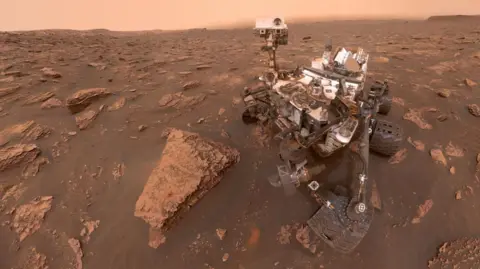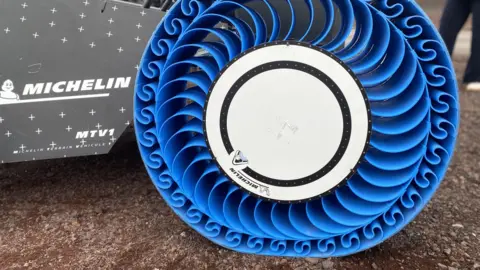Going back to the Moon after half a century, and then to Mars, literally means reinventing the wheel.
After all, Mars is a long way to come back if you get a flat.
“One thing you cannot have is a puncture,” says Florent Menegaux, chief executive of the French tyre-maker Michelin.
The tough conditions on Mars have been underlined by the experience of the unmanned Curiosity rover.
Just a year after landing in 2012, its six rigid aluminium tyres were visibly ripped through with punctures and tears.
As for the Moon, the US Artemis missions aim to return astronauts there, perhaps by 2027.
Later Artemis missions plan to use a lunar rover to explore the Moon’s south pole starting with Artemis V, currently scheduled for 2030.
The Artemis astronauts will be driving much further than their Apollo forebears, who in six landings between 1969 and 1972 never ventured more than 25 miles (40km) across the Moon’s surface.
“The target is to cover 10,000 kilometres in 10 years,” says Sylvain Barthet, who runs Michelin’s lunar airless wheel programme in the central French town of Clermont Ferrand.
“We’re not talking about short, week-long durations, we’re talking about decades of utilisation,” says Dr Santo Padula, who has a PhD in materials science, and works for Nasa as an engineer at the John Glenn Research Centre in Cleveland, Ohio.
 NASA
NASAOne big challenge for anyone developing technology for the Moon are the huge temperature ranges.
At the lunar poles temperatures can plunge lower than -230C, that’s not far off absolute zero, where atoms stop moving.
And that’s a problem for tyres.
“Without atom motion you have a hard time having the material be able to deform and return,” says Dr Padula.
The tyres need to be able to deform as they go over rocks and then ping back to their original shape.
“If we permanently deform a tyre, it doesn’t roll efficiently, and we have issues with power loss,” says Dr Padula.
The new wheels will also carry much bigger loads than the lightweight rovers Apollo astronauts cruised around in.
The next space missions will need to drive round “bigger science platforms and mobile habitats that get larger and larger”, he says.
And that will be an even heftier problem on Mars, where gravity is double that on the Moon.
